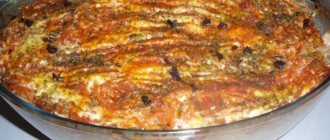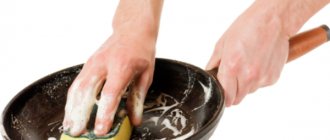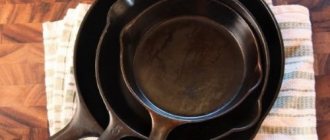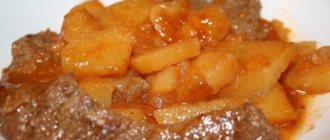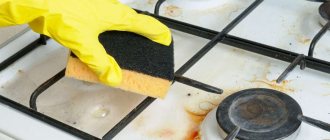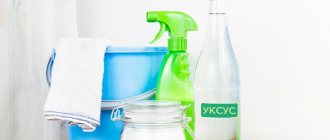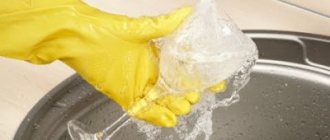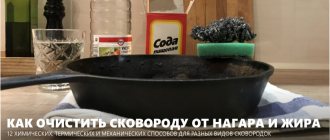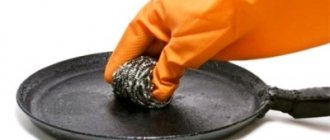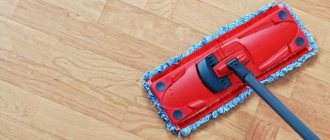Glassware for the oven is beautiful to look at, practical to use, and safe for health. Its disadvantage is that such material is subject to the appearance of soot, grease stains, stains, soot, and other types of contaminants. But you can cope with them by using a folk or commercial remedy. It is important to choose the appropriate composition for this type of cookware.
Soaking in hot water
Instead of vigorously scrubbing the glass mold, it is better to let the carbon deposits dissolve on their own. The dishes are immersed in hot water. After 25–30 minutes, carbon deposits can be easily removed with a wooden spatula. If after the first soaking the result is unsatisfactory, the procedure is repeated. The method works better if you add dishwashing detergent to the water.
Proper cleaning of Teflon and silicone oven trays
Despite the ease of use, products with such a coating require maintenance. Therefore, you need to abandon cleaning powders, and it is better to purchase a specialized product in the store.
Non-stick coatings do not tolerate abrasives and hard metal wool and become unusable.
Teflon absorbs grease well and is not easy to remove later. It is recommended to apply a layer of salt for cleaning and leave it for 10 minutes. Next, pour it out and wash the sheet with detergent.
To get rid of traces of carbon deposits, you can fill the sheet with hot water and add dish gel. After an hour, you can carefully rinse the baking sheet.
Soft plastic and Teflon-coated containers can be cleaned using gentle methods using any non-aggressive dishwashing detergent.
Advice! To prevent traces of grease from remaining on the Teflon surface, washed dishes must be wiped dry immediately.
If the product contains alkali or acid, they cannot be used. It would be better if there is o on the packaging.
When choosing a product to clean a baking sheet from carbon deposits, it is useful to remember folk recipes for detergents.
Toothpaste and ammonia
This mixture easily copes with even a thick layer of carbon deposits and adds shine to the glass. To prepare a cleaning product, a little toothpaste or powder is mixed with a few drops of ammonia. The resulting slurry is applied to the contaminated surface and left for several minutes. The carbon deposits begin to gradually dissolve and are wiped off with a sponge. Then the dishes are washed in clean water.
Reasons for the appearance of soot on an oven tray
Those who often cook at home know how difficult it can be to clean the containers in which food was prepared. To cook food in the oven, the temperature is raised to high temperatures. Fats boil and splash in different directions. When exposed to heat, they stick to the walls of the dish. It takes time for an appetizing crust to form. The drops have time to dry out and stick. They turn into dark soot. The lower layers have time to fry and even burn to the baking sheet.
When baking cakes or muffins, the dough displaces the oil and it flows down the walls. Moisture evaporating from food attracts dust particles in the air. Along with them, dirt settles on the surface and sticks from everywhere. The dishes become dirty on both sides. Experienced housewives know how to clean an oven tray at home. The best ways to remove burnt food and grease from the surface of cookware are presented in this review.
It is better not to use abrasives or hard steel wool to clean the non-stick coating of the baking sheet.
Skill is acquired through trial and error. You need to check several methods to choose a convenient one. Do not neglect the advice of elders.
Hydrogen peroxide and soda
The product is suitable for cleaning old and thick fatty deposits. A small amount of baking soda is diluted with peroxide to the consistency of thick sour cream and applied to the dishes. After 35–40 minutes, the carbon deposits are wiped off with a hard sponge or brush.
These methods will help you deal with stains and restore your dishes to their original appearance.
Source
Sand
It is used to clean vases and decanters from sediment that has formed on the bottom. A glass of the bulk component is placed in the container and water is poured in to cover half the container. Everything is closed and thoroughly shaken, after which the contents are poured out. Fresh water is poured into the container and a small amount of detergent is added. After shaking, the vessel is rinsed under water.
We fight limescale using folk remedies
Baking soda
This method is simple and does not require the use of any complex means. To easily remove stains from glass, sprinkle a little baking soda on a dish sponge. Wipe wet glassware with it, then rinse thoroughly under running water. Unpleasant stains and drops will disappear without a trace!
Vinegar solution
Regular table vinegar diluted in water at room temperature (1 tablespoon of vinegar per glass of water) can also help deal with various marks on the surface of glassware. The solution should be used to wipe trays, jars or salad bowls after thorough washing. It is most convenient to use a spray bottle during the process. If your household does not have it, wet gauze or a piece of cloth with the solution. Wipe the glass thoroughly. You will immediately see how it becomes transparent and shiny. Just remember to rinse the glassware with cool water and wipe dry with a kitchen towel.
Ammonia
Regular ammonia can also help solve the problem at home. You need to pour a small amount of it onto the fabric, then rub it into the surface of the dish with rhythmic movements. After this procedure, all surfaces will sparkle like new!
Lemon liquid
A solution prepared with lemon is no less effective. In a glass of warm water you need to dissolve 20 g of citric acid (usually this is the weight contained in the bag). Now all that remains is to apply the resulting liquid to the glass, wait 10 minutes, and then thoroughly clean the dishes and wash with cool water.
Useful tips
Cleaning glassware will be more efficient if you use a few tips:
- Always remove jewelry to avoid scratching items.
- Rinse in a saline solution to prevent streaking and enhance shine.
- Try to wash dishes with purified water.
- Avoid using washing powder and glass and kitchen detergents.
- Make it a habit not to hoard kitchen utensils, but to wash them right away.
- Soak plates if you cannot wash them.
- Wrap unnecessary dishes in paper and store them in boxes to avoid dust accumulation.
Caring for glass products does not cause much trouble. Glass is durable and resistant to external influences, so the choice of detergents is quite wide. But the appearance of severe contamination can be prevented if care and storage conditions are followed.
1 Comment
I use good old baking soda to clean glassware. The dishes shine, there are no dirty spots or streaks left. Moreover, it is safe, since it is food grade) I also use soda to remove stains on glasses from tea or coffee, and even clean the stove (but I don’t have a glass one, only the glass lid) - everything shines, and it turns out very profitable
Removing carbon deposits and greasy stains from glass baking dishes
Any glassware for the oven sooner or later becomes dirty and acquires a non-specific brownish color. Spots of burnt fat appear on its surface, which are not so easy and quick to remove. Moreover, the appearance of contamination occurs regardless of whether your glassware is inexpensive or elite.
Drops of dried fat are much more difficult to deal with than removing limescale deposits formed from water. Therefore, you will have to resort to stronger and more complex means. But you can also prepare the compositions yourself.
Composition with laundry soap
Not every housewife knows how to clean glassware from grease using laundry soap. Although this is a very old and very effective method that was used by previous generations. The method definitely deserves attention today. Laundry soap will help eliminate grease stains of any kind, even the most old ones.
- laundry soap 72% - 0.5 - 1 pc. (depending on the size of the dishes);
- pure water.
- Using a grater or a sharp knife, you need to make soap shavings and pour them into the dishes that will be cleaned.
- Fill with water so that it does not reach 4-5 centimeters from the upper border of the mold or tray. Place in the oven and preheat the device to 180 degrees. When the contents of the dish boil, the temperature must be reduced.
- Now it is important to let the soap solution simmer for half an hour.
- Then leave the mixture in the oven until it cools completely.
- Only after this can the solution be disposed of and the dishes cleaned with a hard sponge.
Solution with citric acid and vinegar
Thanks to the active substances contained in the well-known lemon and vinegar, the solution is quite powerful. If you don’t know how to clean glassware from carbon deposits and grease, try this one. The method is quite simple and quick to implement. It does not require any expensive components.
- clean water – 1 l;
- table vinegar - 0.5 tbsp.;
- citric acid – 1 tbsp. l.
- The required amount of water must be brought to a boil.
- Next, dissolve vinegar and a spoonful of citric acid in boiling water.
- Soak the tray or baking dish that has oven residue and frozen drops of fat in the resulting solution.
- Leave for 1 hour.
- Then you need to clean the glass surfaces with a stiff brush or brush.
Mustard powder remedy
This effective method will help get rid of even the oldest grease on glassware. In combination with hot water, mustard works real miracles! To see this from your own experience, just try it. The method is simple and absolutely safe.
- hot water – 2 l;
- mustard powder – 100 g.
- Mustard powder must be dissolved in hot water.
- Then you should soak the greasy dishes in the resulting solution.
- Soak the molds and trays in the liquid for 30 minutes or a little more.
- Use the hard side of the sponge to clean off dirt and then rinse thoroughly.
A mixture of PVA glue and laundry soap
This method is suitable for removing carbon deposits from both the outside and inside of dishes. The main thing to remember is that after such cleaning, the molds, pots and trays need to be rinsed well with clean water. The method is very effective, not difficult to implement and quite affordable. Thanks to this, many housewives will like it.
- clean water – 3.5-4 l;
- laundry soap 72% - 1 pc.;
- PVA glue – 1 tbsp. l.
- Pour the required amount of clean liquid into a large container.
- Next, chop the bar of soap into small pieces and place it in water.
- Add a tablespoon of PVA glue there.
- Place contaminated glassware into the solution.
- Boil it for 30 minutes.
- Clean dishes using the hard side of the sponge.
In the dishwasher
PMM is suitable for washing various glass products: plates, pots, glasses, etc. But there are a number of points that need to be taken into account. Not all glass is dishwasher safe. Look for the corresponding mark on the product box.
It happens that upon contact with water whose temperature is more than 40 degrees, the material loses transparency. You will learn about why glass becomes cloudy from You can also wash glasses in the dishwasher, but in the appropriate mode.
It is best to use a gel as a detergent for PMM, which must be selected so that the glass cleaning process is most effective. On the shelves you can find high-quality products with natural composition that will provide maximum cleaning from dirt.
Specialized tablets are most often produced in the form of “3 in 1”, combining the properties of detergent, rinse aid and regenerating salt.
When loading dishes into the PMM, you should adhere to some rules:
- It is necessary to clean the containers from any remaining liquid or food.
- The dishes should be stacked tightly, but not too tightly, so that water can circulate inside the dishwasher.
- Many PMMs are divided into special sections, thanks to which dishes can be placed in different ways.
- Thin glass glasses and similar items are placed on top.
By applying folk methods and using the right products, you can maintain the beauty and transparency of kitchen utensils for a long time.
How to clean glassware from grease: several ways to quickly clean dishes until they shine
They dissolve easily, so they can be used in any washing program. They are also considered an inexpensive and economical option.
Expert opinion
Alexandra Poryadkina, cleanliness expert
Please contact me with any questions!
New products must be hardened to increase resistance to external influences and contamination. Thanks to these simple steps, you can quickly and easily clean the oven from even the most severe dirt. 5 folk remedies to clean glass in the oven until it shines. For advice, contact me, I will definitely answer!
What household products should I use to wash dishes?
- Only those products that are specifically designed for this purpose are suitable for this purpose. Usually there are special inscriptions on their labels. For example, “for washing dishes” or something similar.
- You should choose a product with the largest amount of surfactants (surfactants). They are responsible for foaming and the greater their number, the better the product will lather. Accordingly, it will be possible to wash many more dishes.
- If you do not use rubber gloves when washing dishes, be sure to pay attention to an indicator such as pH. Ideally it should be 5.5. This number corresponds to the pH of human skin.
- It is worth giving preference to products that contain protective components for the skin of the hands - silicone or glycerin. They form a protective film on the skin, which prevents the active substances of the detergent from penetrating deep into the skin. This is worth remembering for those who are not used to using rubber gloves.
Tips for preventing grease from forming on the baking sheet surface
The easiest option to avoid problems with contamination is to use foil or special paper for baking. It is better to wash the baking sheet immediately after preparing the dish. If time is running out and you can’t wash the dishes on time, you should at least fill it with plain water.
One of the most effective means for cleaning carbon deposits is laundry soap.
Otherwise, you can choose one of the following methods to clean the pan. Don't forget about your hands; it is recommended to use gloves.
It is better to wash off leftover food and fat immediately. If time does not allow, you need to soak the dishes in hot water with added detergent.
Precautions when using household chemicals
Every housewife should understand how important it is to follow safety precautions and precautions when using aggressive chemicals. After all, with the wrong approach, there is a high risk of harming your well-being or the health of your household.
- When washing dishes, be sure to use high-quality rubber gloves. They should not contain any breaks on their surface through which chemicals can get onto the skin of the hands.
- It is also necessary to pay attention to the expiration date of the purchased product. If it has already expired, then you should no longer use the substance.
- Do not use household chemicals in the presence of young children. It is also important not to leave bottles within a child’s reach, especially with open caps.
- After using household chemicals, it is important to thoroughly rinse the dishes with clean running water. Otherwise, the active substances will enter the digestive tract during food intake. This can cause allergies or even poisoning.
- Dishwashing detergents, like any other household chemicals, should be stored away from food products.
To keep glass jars and baking trays looking clean and shiny, it is important to care for them properly. Timely washing and cleaning with high-quality home or store-bought products will help achieve success. If you don’t know how to clean glassware from limescale or remove drops of old grease on glass surfaces, then use the products presented in this article.
Source
How to prevent cloudy glass
To ensure that glassware retains its shine, shade and presentable appearance longer, try to wash the glassware by hand and store it in a cool, dry place. Choose special mild detergents, soft sponges and wipes. Wash items without rings or bracelets on your hands. Do not use powders or abrasive compounds!
During the washing process, do not allow sudden temperature changes. It is better to wash items in warm or cool water and rinse in cold water. After water procedures, do not wipe the products, but leave them to dry naturally upside down. If necessary, you can wipe items with a linen towel or napkins, since linen does not leave lint.
If you do not use glassware for a long time, the products need to be washed periodically. Do this once every three months in cool water without using special products.
When washing items in the dishwasher, place items so that they do not rub against each other. After completing the process, immediately open the machine door to reduce the humidity and air temperature. For dishes that can be safely washed in the dishwasher, see the link.
How to clean a baking sheet and a glass baking dish from carbon deposits: three simple ways
Remember what your baking sheet looked like when you purchased it - it was probably shiny, smooth and beautiful. But, unfortunately, after some time the baking sheet, like other kitchen utensils, becomes covered with a dark layer of soot . You can't throw it away and clean it up. Where will you put the comma? Of course, if you're reading us, you'll jump right into it. They say it's incredibly difficult to clean the pan. The editors of So Taste do not agree with this statement.
There are many ways to give an old baking sheet new life. Of course, you can purchase special products. But, unfortunately, they do not always work, and they contain a lot of unnecessary chemicals. Some cause skin irritation if you work without gloves. Another side effect is allergies. And no matter how many flavors are added, the unpleasant smell in the kitchen can remain for another half a day. Therefore, we recommend that you try proven folk methods . They help get rid of even old carbon deposits and dirt.
How to Clean a Stainless Steel Pan
You will need
- 2 tbsp. l. water
- 2 tbsp. l. distilled vinegar
- A bowl
- Sponge for washing dishes
Application
- Combine water and white vinegar in a bowl.
- Place the mixture on the fire and bring the liquid to a boil. Then let it cool to room temperature.
- Soak a sponge in the prepared water and vinegar and wipe the baking sheet with it.
- Wash the baking sheet with soapy water, rinse under running water, and then dry.
Boil the liquid over low heat only. Wear gloves to prevent liquid from getting on your hands. After using the product, rinse the bowl with hot water. It’s better to leave the sponge aside until the next time you use the solution.
How to clean a glass baking dish
You will need
- 100 g soda
- 1 tsp. dish detergent
- 1 tbsp. l. hydrogen peroxide
- hard sponge for washing dishes
Application
- Mix all three ingredients to form a smooth white paste. Add more peroxide and detergent if necessary.
- Spread the mixture onto a dirty baking sheet. After 10-15 minutes, take a stiff sponge and clean the surface.
Glass forms are very convenient to use . It would seem that they are so easy to clean! But if the remains of the dish dry out, then when cleaning the glass may acquire small scratches. And over time, it generally seems to fade. Baking soda will help give it back its former shine.
Prevention is the best remedy
Congratulations on successfully cleaning even the oldest baking sheet. Now, so that the problem does not arise again, and you do not spend even a split second on preparing the product and cleaning, think about prevention. Use parchment paper. It is she who will bear the brunt. We removed the paper after baking and got rid of the problem. Simply wipe the baking tray with a damp sponge after use and put it back in place.
• Scientists have discovered several previously unknown types of coronavirus in bats
• Trinity in 2022: traditions and prohibitions of the church holiday
• Warm but wet: weather forecast for the weekend in Ukraine
Features of cleaning glass and ceramic baking trays from old fat
Mechanical cleaning with abrasives can only scratch the surface made of such materials. However, there are other chemical methods, including:
- sprinkle the bottom with mustard and pour hot water (it’s better to leave it overnight, and just rinse with running water in the morning);
- Baking powder works well with old fat; first, sprinkle it on the surface of the sheet, and then moisten it (you can use a spray bottle). After half an hour, rinse with water;
- In a ratio of 3 to 1, take soda and salt, dilute with water (the composition should be thick). Apply to a baking sheet and leave overnight; in the morning, washing off the dirt with water will not be difficult.
The metal does not react with mustard. Its cleaning properties have been known since ancient times.
When choosing specialized products in stores, it is important to read the ingredients. It is better if there is a mark “for glass”, “for ceramics”.
How should you wash glassware?
If there are drops of fat, food residues in the grooves and even limescale deposits that noticeably spoil glassware, you can use one of the following remedies:
- Food foil and baby soap. Take a piece of food foil and crumple it thoroughly, turning it into a “metal sponge”. We place the glass item under running hot water and begin to scrub its surface with foil. After the desired result is achieved, rinse the product with very warm water mixed with shavings of baby soap. Rinse the dishes with a cool stream from the tap and rub with a linen cloth.
Tip: In order to clean products covered with old fat efficiently and without unnecessary fuss, you first need to roll them in fine table salt and leave for half an hour. After this, we remove the dirt from the surface mechanically and proceed to cleaning using one of the given methods.
- Mustard powder. We take warm water into a sink or basin and dilute 2 teaspoons of dry mustard powder in it. We prepare another basin with warm water. Soak glass objects in mustard solution for literally five minutes. We take them out one at a time and wipe them with a damp cloth, then rinse them in warm water. There is no need to wash things directly in mustard! If it was not possible to clear the dirt the first time, repeat the entire procedure from the beginning.
We recommend: 6 rules for general kitchen cleaning – we can get it done as quickly as possible
- Ammonia. An effective way to rid glassware of drops and stains so that it sparkles and shines. Immediately before the items are used, soak them for one hour in a solution prepared from water and ammonia (a teaspoon of the product for every liter of water). After this, carefully wash with a soft cloth, wipe dry without rinsing, and expose to fresh air for half an hour.
- 9% vinegar. This method is best used immediately after using the dishes. Items should be cleaned of food debris and soaked in a sink with warm water and two tablespoons of 9% vinegar. For maximum effect, each product should be washed for at least a minute. Then rinse the dishes in clean water and dry.
- Baking soda. With its help, you can quickly clean massive products covered with stubborn stains. First, rinse it in warm water, then dip a damp cloth or sponge in soda and rub the surface for 1-2 minutes. Treated items should be washed first in warm, then in cold water.
- Crushed eggshells. With its help, you can easily wash the inside of glass household items with a narrow neck. We crush the washed and dried eggshells to a powder, pour them into dirty dishes, add a little water mixed with shavings of baby soap. We clamp the neck and thoroughly shake the object for several minutes. We rinse it with warm, then cold water. If necessary, repeat again.
- Potato chips. It can be used in the same way as in the previous method, or used for rubbing massive surfaces. The main thing is to wash with gentle movements without strong pressure and rinse the product thoroughly with cold water.
The above methods allow you not only to thoroughly wash glass utensils, but also to prevent the formation of chips, stains, and “rusty” stains on the surface.
We recommend: We wash the blender without disassembling it, quickly and with one click of a button.
Why does glass become cloudy?
There are many reasons for the aging of the glass surface. One of them is associated with the use of too aggressive detergents. Negative factors include increased water hardness, high temperature of the washing liquid, as well as physical friction when dishes are placed too closely together.
Therefore, to avoid aging and clouding, use gentle cleaning compounds, do not place items close together, especially when washing in the dishwasher, and use different filters or other methods to soften the water.
The quality of tableware production plays an important role in the rate of glass aging. The presence of a large number of microcracks on the surface, which we cannot see with the eye, will eventually cause the development of glass corrosion and corrosion of the material under the influence of alkali. Such damage is already irreversible, and such defects can only be dealt with at the initial stage.
To keep glass appliances in their original form, it is important to properly care for the products. Let's look at how to wash glassware without streaks so that it sparkles and shines.
Prevention is the best remedy
Congratulations on successfully cleaning even the oldest baking sheet. Now, so that the problem does not arise again, and you do not spend even a split second on preparing the product and cleaning, think about prevention. Use parchment paper. It is she who will bear the brunt. We removed the paper after baking and got rid of the problem. Simply wipe the baking tray with a damp sponge after use and put it back in place.
Using these methods you can quickly get rid of carbon deposits or dirt . It turns out that everything is so simple. You will save not only on the purchase of expensive chemicals! Now, instead of spending an hour or more at the sink, you can communicate more with your family. Save these useful tips and use them for your health! And tell your friends about the economical approach.
Source
Solution with citric acid and vinegar
- Fill the bottom of the pan with sand.
- Lay out the dishes.
- Fill with cold water. The container must be completely immersed in liquid.
- Heat and boil for 15 minutes.
- Add 2 tbsp. l. salt.
- Boil for 30 minutes.
- Cool. Don't pull it out!
- Remove and rinse in warm water.
This effective method will help get rid of even the oldest grease on glassware. In combination with hot water, mustard works real miracles! To see this from your own experience, just try it. The method is simple and absolutely safe.
Effective shine products
In most cases, ordinary water is not enough to make glass kitchen appliances shine. Fingerprints, stains and plaque may remain on their surface. To solve the problem, you can use the following available methods:
- Laundry soap. Using this affordable product, you can wash glassware from plaque and other contaminants so that it sparkles again. But this needs to be done in cool water, and then wipe the products with a linen towel that does not leave lint.
- Vinegar. To do this, you need to pour cool water into a basin and add 2-3 tablespoons of the active substance to it. Then the utensils should be placed in the prepared mixture, washed thoroughly and rinsed in running water.
- Ammonia. The substance must be filled with water and the contaminated glass placed there. For 1 liter of water, 1 teaspoon of ammonia is required. This product not only removes dirt, but also restores shine to glass products.
- Salt. The salt solution copes well with plaque and various contaminants. Washed items should not be dried.
- Mustard. Add 3-4 teaspoons of regular mustard powder to a small bowl of slightly warmed water. The resulting mixture is used to treat not only plates and glasses, but also spoons.
- Lemon. It can be used either pure or diluted in water.
Recommendations
- If the oven has removable shelves and racks, they must be cleaned separately. To do this, you can immerse them in a container of warm water and add dishwashing liquid.
- Large accumulations of fat and burnt food must first be scraped off.
- When applying cleaning agents, you need to act carefully, because they should not come into contact with door seals and heating elements.
- Any cleaning product takes time, so don’t rush or rush things.
- To clean the oven, you can use medium-hard brushes.
- Remove detergent with a clean and slightly damp cloth.
- The main thing is to try to remove burnt food and grease immediately after cooking or at least once a week. This way you can protect yourself from stubborn stains and grease deposits.
You can clean glass using a conventional steam generator. It will clean dirt of any complexity with a powerful jet. Will not damage glass surfaces. But not everyone has such a thing at home. Don't despair. You just need to take a heat-resistant container and pour water into it. And you can also add dishwashing liquid. Place the dishes in a preheated oven at 150 degrees and bring to a boil. Leave to evaporate for half an hour. After everything has cooled, remove any softened dirt.
How to wash the oven door between the glass - Construction, repair, arrangement
- You cannot clean enamel and glassware with a metal sponge (scratches will appear in which dirt will accumulate);
- powder with abrasive particles is not suitable for washing dishes made of enamel and glass;
- the remaining food from the aluminum baking sheet can be easily removed with a wooden spatula;
- To make the baking tray (glass, aluminum, enameled) easier to clean, it should be left in warm water diluted with liquid detergent.
It is convenient to monitor food preparation through clean, transparent glass, especially if it is baking, and the door cannot be opened during the process. Recipes do not always indicate the correct temperature or cooking time for the pie, so you need to constantly monitor the process
What solutions should I use?
The simplest option is to purchase a ready-made cleaning product for porcelain and ceramics. They contain abrasive substances, but they have a gentle, polishing effect. But cleaning solutions do not contain acids, alkalis, chlorine and its compounds, ammonia, phosphates, to which fragile materials are so vulnerable.
Ready-made products are used according to the instructions on the packaging:
- The container in which they are poured must be shaken before use.
- Then pour a small amount of solution onto a cotton pad.
- Wipe the product with a disc, paying more attention to hard-to-reach areas.
- Rinse the dishes under running warm water.
- Dry properly.
What to do if items are heavily soiled and there is no solution in the apartment? In case of heavy contamination, porcelain can be cleaned with a 3% hydrogen peroxide solution. It is necessary to moisten a soft sponge or cotton pad in a small amount of H2O2, then easily wipe the most contaminated areas and rinse under cool water.
Dark marks from tea and coffee remain in cups, saucers and teapots, and lipstick marks remain on the rims. Soda gruel removes such contaminants well. To prepare it, you need to put a pinch of baking soda on a soft sponge, moisten the soda with water and mash it with your fingers until a paste forms. Then gently rub the stained areas. Instead of soda, you can use tooth powder moistened with water.
Citric acid or wine vinegar will help remove yellowness and restore its former shine. You need to moisten a microfirbe flap in them and lightly wipe the products inside and out. This type of cleaning is not suitable for porcelain with painting, gilding or silvering. They are washed by hand, without any products and very delicately.
Where to begin?
The answer to this question depends on several factors:
- Do you have a large family and do you often have to wash dishes?
- how dishwashing detergents act on the skin;
- which means are used more often: folk or industrial;
- Do you have a lot of greasy dishes?
- Do you have to wash bottles (for example, baby bottles).
In addition to gloves and an apron, you should stock up on various sponges, brushes, pipe cleaners, and scourers with metal threads. Depending on your preferences, you will need liquid and dry detergents for different types of dishes to remove plaque, grease, and burnt-on food. Some types of dishes can and should be washed with cold water, but it is still difficult to do without hot water. If there is no running water, you will need a basin or dish. In nature, this role is usually performed by a bucket.
The following rules should also be observed:
- Before washing dishes, remove any leftover food to avoid clogging the sink.
- Don't forget about sorting and washing dirty items.
- Each piece of cookware has two sides: the inside and the outside, and both of them need to be washed.
- It is much easier to clean greasy utensils after soaking.
- Drying is carried out in one of two ways: natural drying upside down or drying with a towel.
